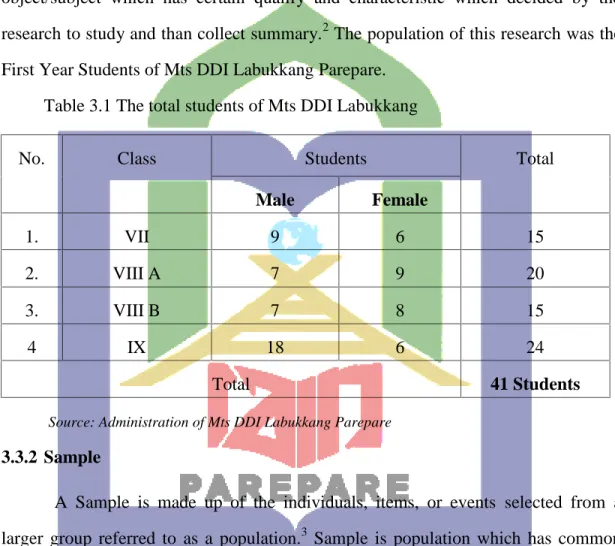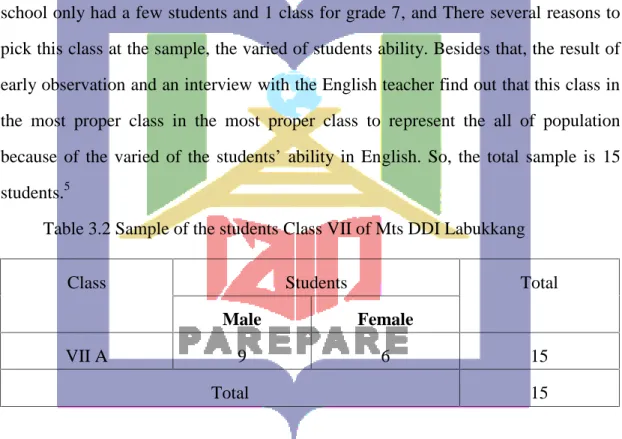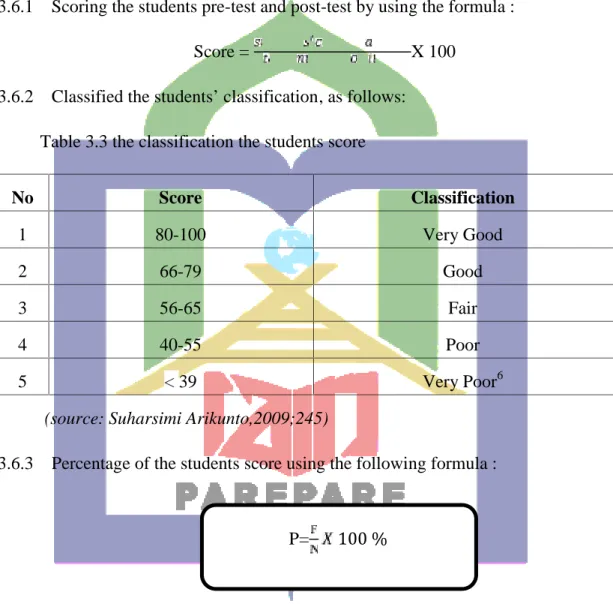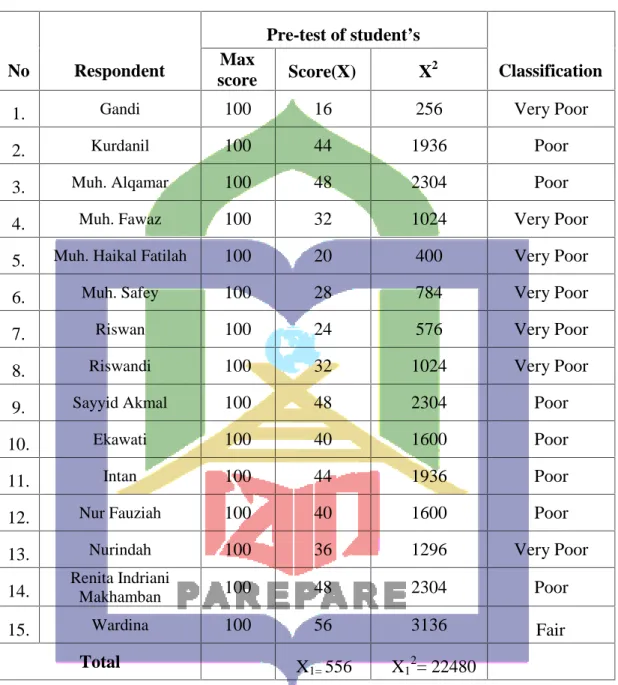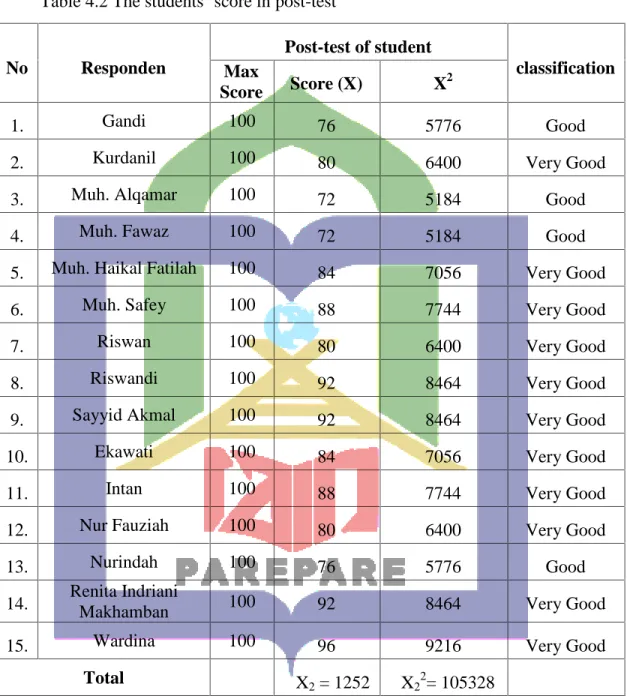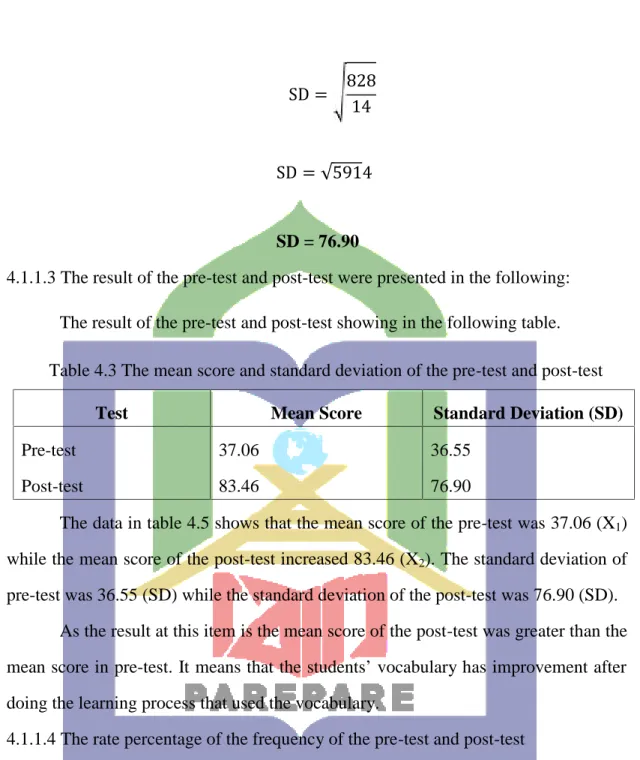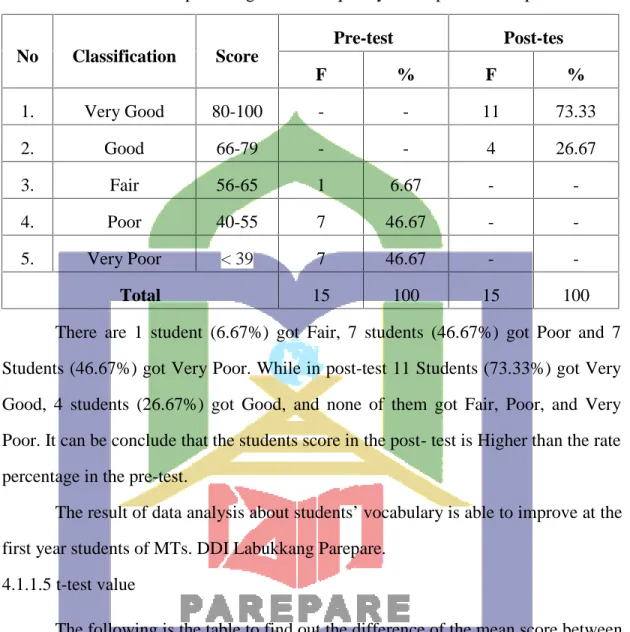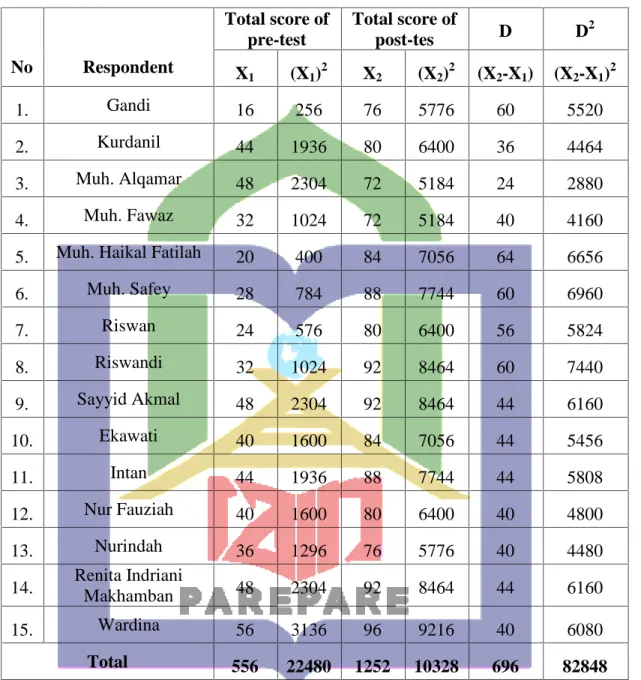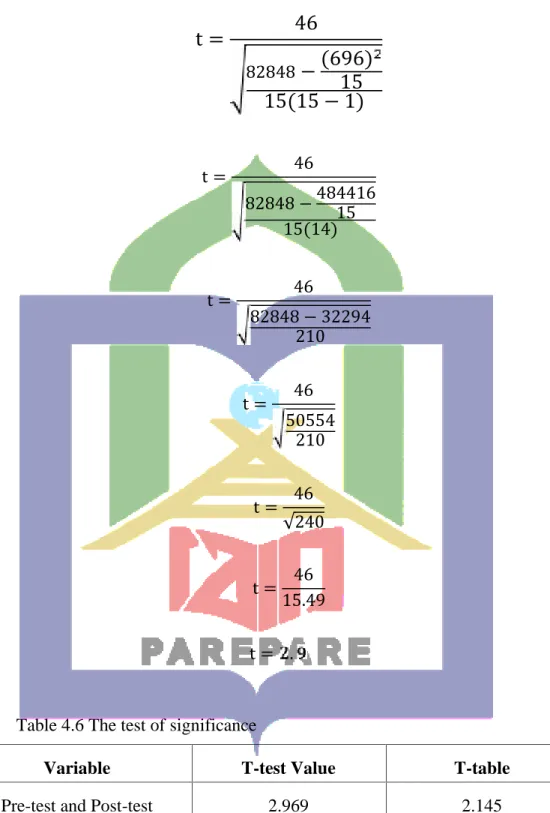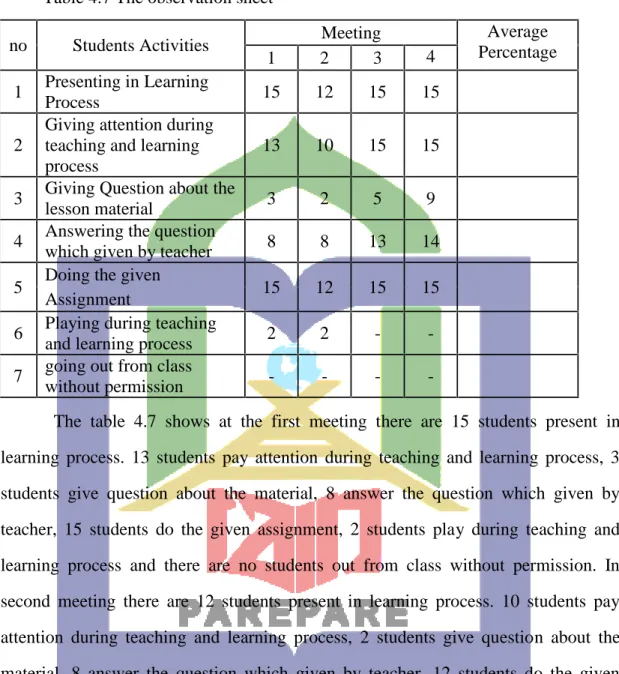SKRIPSI
THE USE OF STUDENTS TEAM ACHIEVEMENT DIVISION (STAD) MODEL IN IMPROVING THE STUDENTS VOCABULARY
OF THE FIRST YEAR STUDENTS OF MTs. DDI LABUKKANG
PAREPARE
By
DARNIATI Reg Num. 14.1300.074
ENGLISH PROGRAM
TARBIYAH AND ADAB DEPARTMENT STATE ISLAMIC INSTITUTE (IAIN)
PAREPARE 2019 SKRIPSI
THE USE OF STUDENTS TEAM ACHIEVEMENT DIVISION (STAD) MODEL IN IMPROVING THE STUDENTS VOCABULARY
OF THE FIRST YEAR STUDENTS OF MTs. DDI LABUKKANG
PAREPARE
By
DARNIATI Reg Num. 14.1300.074
ENGLISH PROGRAM
TARBIYAH AND ADAB DEPARTMENT STATE ISLAMIC INSTITUTE (IAIN)
PAREPARE 2019 SKRIPSI
THE USE OF STUDENTS TEAM ACHIEVEMENT DIVISION (STAD) MODEL IN IMPROVING THE STUDENTS VOCABULARY
OF THE FIRST YEAR STUDENTS OF MTs. DDI LABUKKANG
PAREPARE
By
DARNIATI Reg Num. 14.1300.074
ENGLISH PROGRAM
TARBIYAH AND ADAB DEPARTMENT STATE ISLAMIC INSTITUTE (IAIN)
PAREPARE
2019
ii PAREPARE
By
DARNIATI Reg Num. 14.1300.074
Submitted to the English Program of Tarbiyah and Adab Depatment State Islamic Institute (IAIN) of Parepare in Partial of
Fulfilment of the Requirements for the Degree of Sarjana Pendidikan (S.Pd)
ENGLISH PROGRAM TARBIYAH FACULTY
STATE ISLAMIC INSTITUTE (IAIN) PAREPARE
2019
ii PAREPARE
By
DARNIATI Reg Num. 14.1300.074
Submitted to the English Program of Tarbiyah and Adab Depatment State Islamic Institute (IAIN) of Parepare in Partial of
Fulfilment of the Requirements for the Degree of Sarjana Pendidikan (S.Pd)
ENGLISH PROGRAM TARBIYAH FACULTY
STATE ISLAMIC INSTITUTE (IAIN) PAREPARE
2019
ii PAREPARE
By
DARNIATI Reg Num. 14.1300.074
Submitted to the English Program of Tarbiyah and Adab Depatment State Islamic Institute (IAIN) of Parepare in Partial of
Fulfilment of the Requirements for the Degree of Sarjana Pendidikan (S.Pd)
ENGLISH PROGRAM TARBIYAH FACULTY
STATE ISLAMIC INSTITUTE (IAIN) PAREPARE
2019
iii
THE USE OF STUDENTS TEAM ACHIEVEMENT DIVISION (STAD) MODEL IN IMPROVING THE STUDENTS VOCABULARY
OF THE FIRST YEAR STUDENTS OF MTs. DDI LABUKKANG
PAREPARE
Skripsi
As Partial Fulfillment of the Requirements for the Degree of Sarjana Pendidikan (S.Pd)
English Program
Submitted by
DARNIATI Reg Num. 14.1300.074
to
ENGLISH PROGRAM
TARBIYAH AND ADAB DEPARTMENT STATE ISLAMIC INSTITUTE (IAIN)
PAREPARE
2019
iv
(STAD) Model in Improving the Students Vocabulary of the First Year Students of MTs.
DDI Labukkang Parepare Student Reg. Number : 14.1300.074
Department : Tarbiyah and Adab
Study program : English Program
By Virtue of Consultant Degree : SK. The Chairman of Tarbiyah and Adab Department Sti.08/PP.00.9/2706/2017
v
SKRIPSI
THE USE OF STUDENTS TEAM ACHIEVEMENT DIVISION (STAD) MODEL IN IMPROVING THE STUDENTS VOCABULARY
OF THE FIRST YEAR STUDENTS OF MTs. DDI LABUKKANG
PAREPARE
Submitted by
DARNIATI Reg Num. 14.1300.074
Had been examined of January 10th, 2019 and had been declared that it fulfilled the requirements
Approved by Consultant Commissions Consultant : Dr. Abu Bakar Juddah, M.Pd.
Nip : 19600505 199102 1 001
Co- Consultant : Drs. Amzah, M.Pd.
Nip : 19671231 200312 1 011
vi
(STAD) Model in Improving the Students Vocabulary of the First Year Students of MTs.
DDI Labukkang Parepare.
Student Reg. Number : 14.1300.074
Department : Tarbiyah and Adab
Study Program : English Program
By Virtue of Consultant Degree : SK. The Chairman of Tarbiyah and Adab Department Sti.08/PP.00.9/2706/2017 Date of Graduation : January 10th, 2019
vii
ACKNOWLEDGEMENT
In the name of Allah, The Beneficent and The Merciful
Al-ḥamdu li-llāhi rabbil-ʿālamīn. the researcher express her highest gratitude to Allah swt. the lord of the universe. Allah swt. always gives strong and favor in completing this “Skripsi” by the title “The Use of Students Teams Achievement Division (STAD) Model in Improving the Students Vocabulary of the First Year Students of MTs. DDI Labukkang Parepare”. Blessing and salvation be upon beloved prophet Muhammad saw. and his family, his companions, and his followers.
The researcher wants to thank a lot to all people who support and help her.
She realizes that without their support and help, she could not be able to finish this
“Skripsi”.
In this opportunity, the researcher would like to express her gratitude to Dr.
Abu Bakar Juddah, M.Pd and Drs. Amzah, M.Pd for their valuable advice, guidance, dedication, correction, suggestions, and support to her in finishing this “Skripsi”.
There are also some people that the researcher would like to appreciate:
1. The really great thanks and appreciation to her mother Isakka for their prayers, pure love, countless material, and work hard for the researcher’s success.
2. The rector of State Islamic Institute (IAIN) Parepare, Dr. Ahmad Sultra Rustan, M.Si and his staffs their help and motivation during she finished her study.
viii fabulous serving to the students.
5. Dr. H. Saepuddin, S.Ag., M.Pd. and Dr Abdul Haris Sunubi, S.S., M.Pd. as a examiner commission who have helped the researcher in finishing the study.
6. All lecturers of English Education Program who have already taught the researcher during her study in IAIN Parepare.
7. Drs. Nurdin Samad. MA the headmaster of MTs. DDI LABUKKANG Parepare and Kamalia, S.Pd.I as English teacher of MTs. DDI LABUKKANG Parepare who has given the researcher advices in teaching and doing the research and also the first year students, their participation and time for being the subject in this research.
8. The researcher beloved brother and sister Muh. Fajri, Muh. Takbir, Dahniar, Darlina, Mawar, also her sister in law Febby Pratiwi Razak, S.E and Nurlaila for their support and motivation to her.
9. All her best friends in English Department in year 2014 for their help, brotherhood, togetherness and advices. Especially for Andi. Rahmania, Fitriani.S, Risda Sinring, Fitriani.L, Hartina, and Eka who are always with her to face all happiness, sadness, and always support guidance, accompany in the process of her study.
Finally, the researcher offers her thanks and apologizes for all people whose names could not all be mention there, for their help, services, ideas, suggestion, and advice in completing this skripsi. This skripsi is still far from
ix
being perfect and therfore all constructive critic and suggestion will be appreciated.
May the Almighty Allah swt be always with us
Parepare, 19thNovember 2018 The Writer
x
Name : DARNIATI
Student Reg. Number : 14.1300.074 Study Program : English Education Department : Tarbiyah and Adab
Tittle of Skripsi : The Use of Students Teams Achievement Division (STAD) Model in Improving the Students Vocabulary of the First Year Students of MTs. DDI Labukkang Parepare.
Stated this skripsi was her own writing and if can be proved that it was copied, duplicated or complied by any other people, this skripsi and the degree that has been gotten would be postponed.
Parepare, 19thNovember 2018 The Writer
xi
ABSTRACT
Darniati. The Use of Students Teams Achievement Division (STAD) Model in Improving the Students Vocabulary of the First Year Students of Mts. DDI Labukkang Parepare (Supervised by Abu bakar Juddah and Amzah).
The purpose of this study was to find out whether or not the significance difference of the vocabulary of students through the STAD Model First Year Student Mts.DDI Labukkang Parepare. Furthermore, the importance of this research is expected to be useful information for English teachers especially in vocabulary teaching. In addition, it can be used as a teaching model to improve the ability to memorize vocabulary.
This study was designed using pre-experimental. The population was students MTs. DDI Labukkang Parepare 2017/2018 academic year and took class 7 as a sample consisting of 15 students. Then, data was collected using vocabulary tests, which were applied in pretest and post-test in the class. During the process, the researcher applied fourth meetings for this class.
After analyzing the data, the researchers found that there was a significant effect using the Sudents Team Achievement Division (STAD) on vocabulary of the First Year Students in Mts. DDI Labukkang Parepare , where the t-test (2.969) was greater than t-table (2.145) with df = n - 1 = 14, with α = 5%. This means that the alternative hypothesis (Ha) is accepted and the null hypothesis (Ho) is rejected. It can be concluded that there is a significant difference from students' vocabulary ability through the STAD learning model before and after treatment.
Keywords: STAD learning model, Students Vocabulary.
xii
SUBMITTED PAGE ... iii
ENDORSEMENT OF CONSULTANT COMMISSIONS ... iv
ENDORSEMENT OF EXAMINER COMMISSIONS ... vi
ACKNOWLEDGEMENT ... vii
DECLARATION OF THE AUTENTICITY OF THE SKRIPSI...….... x
ABSTRACT... xi
TABLE OF CONTENTS... xii
LIST OF TABLES ... xiv
LIST OF FIGURES ... xv
LIST OF APPENDICES ... xvi
CHAPTER I INTRODUCTION 1.1 Background……… 1
1.2 Problem Statement………. 4
1.3 The Objective of the Research………... 4
1.4 The Significance of the Research……….. 4
CHAPTER II REVIEW OF RELATED LITERATURE 2.1 Some Pertinent Ideas………. 5
2.1.1 The Concept of STAD………... 5
2.1.1.1 Definition of STAD……….. 6
2.1.1.2Procedure of STAD……….. 7
2.1.1.3 Component of STAD……… 10
2.1.1.4 The Advantage and Disadvantages of STAD…... 11
2.1.2 The Concept ofVocabulary……….. 12
2.1.2.1 Definition ofVocabulary………... 12
2.1.2.2 The Type of Vocabulary……… 13
2.1.2.3 Importance of vocabulary……….. 16
2.1.2.4 How to Teach Vocabulary………. 16
2.1.2.5 Technique of Learning Vocabulary………... 17
xiii
2.2 Previous Research Finding……… 18
2.3 The Conceptual Framework……….. 20
2.4 Hypothesis………. 21
2.5 Variable and Operational of Research………... 22
CHAPTER III METHOD OF THE RESEARCH 3.1 Research Design……… 23
3.2 Location and Duration of the Research………. 23
3.3 Population and Sample……….. 24
3.4 The Instrumen of Research………... 26
3.5 Procedure of Collecting Data………. 26
3.6 Technique of Data Analysis………... 30
CHAPTER IV FINDING AND DISCUSSION 4.1 Description of the Finding Research……… 33
4.2 Discussion……….. 47
CHAPTER V CONCLUSION AND SUGGESTION 5.1 Conclusion………. 58
5.2 Suggestions……… 59
BIBLIOGRAPHY……….. 60
APPENDICES……….. 63
xiv 3.1
3.2 3.3 4.1 4.2 4.3
4.4
4.5
4.6
The Population of the Tenth Year Students of MTs. DDI LABUKKANG Parepare
The Total of sample
The Classification of Students’ Score The Students’ Score in Pre-test TheStudents’ Score in Post-test
The Mean Score and Standard Deviation of the Pre-test and Post-test
The Rate Percentage of the Frequency of the Pre-test and Post-test
The Worksheet of the Calculation of the Score on Pre-test and Post-test.
The Test of Significance
24
25 30 34 36 38
49
40
41
xv
LIST OF FIGURES Number
of Figures
Tittle of Figures Pages
2.3 3.1
The Conceptual Framework of the Research The Formula of the Research Design
20 23
xvi 2
3 4 5 6 7 8 8
Material of the Treatment
Instrument of the Pre-test and Post-Test Observation Sheet
Students Score Pre-test and Post-test The T-test Value
Distribution of T-Table Result of Pre-Post Students Pictures
83 95 101 106 107 108 109 115
1
CHAPTER I INTRODUCTION
1.1 Background
Education is an important condition for the progress of a nation, because education is the basis of character formation of the nation. Education is a conscious effort and activity that people do in order to improve their personality by fostering their potential, spiritual that includes thoughts, tastes, intentions, creations and conscience and body. This relates to the statement of National Education System no.
20 CHAPTER II Article 3 of 2003 which reads:
National Education serves as the development of the ability and the formation of the character and civilization of a dignified nation in order to educate the nation's life, aims to develop the potential of students to become human beings who believe and piety to God Almighty, healthy, knowledgeable, capable, creative, independent and become a democratic and responsible citizen.1
The success of education is generally judged by the acquisition of knowledge, attitudes and skills. All of this can be achieved through an effective, efficient and meaningful learning process. One of the efforts to achieve the condition is by choosing the right and interesting teaching methods and able to provide a steady and meaningful understanding for the students. In order for the chosen teaching method to succeed the teacher is required to be skilled and dexterous in presenting the learning materials.
In this case the teacher as the spearhead of educational implementation in the field is expected to play a facilitator who will facilitate learners in learning, and learners themselves who must actively learn from various sources of learning. The
1Undang-Undang RI No. 14 Tahun 2003, Tentang Sistem Pendidikan Nasional Tahun 2003 (Jakarta: CV. Mini Jaya Abadi, 2003), p.5.
learning process begins with basic skills in reading, writing, and counting so that later children can meet the demands in the community. And also in seeing the development of today's foreign language skills are also needed both in social communities, the world of work or in the field of education.
Language is an intimate part of social identity used by speakers in natural communication as a legitimate form expression of human idea and feelings. There are many language used by people in various parts of the world, one of them is English. English as an international language is very important to master because almost all communication in the world used English.
In English there are four skills that are known as language skills. The skills are reading, writing, speaking, and listening. It means that the students are expected to develop these language skill through the activities given in the class. To support the development of the four language skills, the learning of language components is needed. The language components of consist of pronunciation, grammar and vocabulary.
Vocabulary is one of the language components that have an important role in the development of the language skills because for large majority of learners, the ultimate goal of studying is to be able to communicate. The importance of vocabulary is demonstrated daily in and out the school. In classroom, the achieving students possess the most sufficient vocabulary.2For example the students can not read well if they do not have vocabulary because they will difficult to translate it. But in increasing students vocabulary is not easy.
2Mofareh Alqahtani, “The Importance of Vocabulary in Language Learning and How ToBe Taught”(International Journal of Teaching and Education, Vol III, No 3/2015), p. 22.
3
To improve the student’s ability, teacher has to design many methods in the classroom. There are many methods, approach, strategy or learning model in teaching English one of them Cooperative Learning. This learning models has been reported to improve students’ Vocabulary, and their knowledge retention. Cooperative learning comprises “instructional methods in which teachers organize students into small groups, which then work together to help one another learn academic content”.
Cooperative learning consists of five basic elements: positive interdependence, promote interaction, individual accountability, teaching of interpersonal and social skills, and quality of group processing.
Based on the explanation above, the researcher would like to conduct a research entitled on “The Use of Students Teams Achievement Division (STAD) Model in Improving the Students Vocabulary of the First Year Students of Mts.
DDI LabukkangParepare”.
1.2 Problem Statement
Based on the background explained above the Problem statement of the research as follow :
Is the use of Students Teams Achievement Division (STAD) Model able to Improve the Students vocabulary of The First Year Students of Mts. DDI Labukkang Parepare?
1.3 The Objectives of the Research
Relating of the problem statement, the researcher decided the objective of the research is to examine:
To find out the use of Students Teams Achievement Division (STAD) Model able to Improve the Students vocabulary of The First Year Students of Mts. DDI Labukkang Parepare?
1.4 Significance of the research
This research is expected to give contribution for the teachers, students, and the other researcher. The kinds of contribution that will be gotten by them are going to be describe as follow:
1.4.1 For the students
This research is expected to enrich the knowledge and can be active of the students in their English class.
1.4.2 For the Teacher
This Researcher can give some information to the teacher about Students Teams Achievement Division (STAD) Model for English teaching.
1.4.3 For the other researcher
The Researcher hope the other researcher can be find many reference to conduct similar researcher Students Teams Achievement Division (STAD) Model.
5
CHAPTER II
REVIEW AND RELATED LITERATURE
This part describes about the description of some pertinent ideas, The Previous Related Finding, Conceptual Framework, Hypothesis and Variable and Operational Definition.
2.1 Some Pertinent Ideas
2.1.1 The Concept of Students Teams Achievement Division (STAD) Model Before knowing about the concept of Students Teams Achievement Division (STAD) Model, it is better to know the concept of model first. Dewi Salma in her book stated the model is a graphic appearance, work systematic procedure that contain of though such as explanation and suggestion.1Sanjaya stated that the group learning model is a series of learning activities undertaken by students in certain groups to achieve the learning objectives have been formulated. There are four important elements of a cooperative learning strategies, they are the presence of the participants in the group, the existence of a rule group, an attempt of learning each member of the group, and the existence of the objective to be achieved.2
In STAD model, students are assigned to four-member learning teams that are mixed in performance, level gender and ethnicity. It is also accelerate the achievement of all students work together to learn and responsible for their teammates learning as well as their own.
1Dewi Salma Prawiradilaga, Prinsip Disain Pembelajaran Instructional Design Principles, First Edition (Jakarta: Kencana, 2008), p. 33
2Sanjaya, Strategi Pembelajaran (Berorientasi Standar Proses Pendidikan), (Jakarta: PT.
Kencana, 2012), p. 241.
There are three concept that are central to Students Team Achievement Division (STAD), are:
1. Teams Rewards
Teams may earn certificates or rewards if they achieve above a designated criterion. However, there is no competition among the students.
2. Individual Accountability
It means that in Students Team Achievement Division (STAD), the teams success depend on the individual learning of all team members.
3. Equal Opportunity for success
It means that what students contribute to their teams is according to their improvement over their own past performance. From the several statement above, the writer sums up that the Students Team Achievement Division (STAD) is a learning techniques where students are assigned to four or five member learning teams that are mixed in performance level, gender, and ethnicity. Students have equal opportunity to learn and students are rewarded for doing better than they have in the past, they will be more motivated.3 2.1.1.1 Definition of STAD (Student Teams and Achievement Divisions) Models
Students Team Achievement Division (STAD) Model or commonly called as a STAD had been defined by some of experts as references in this research, such as in Zainal Aqib book. He stated that STAD Model is a simple way in teaching that is introduce by Slavin.4 Calderon book. He stated in STAD model the students make a
3Gebhard, Jerry G, Teaching English as a Foreign Language or Second Language, (Michigan: The University of Michigan Press, 2006), p. 116
4Zainal Aqib, Model-Model, Media dan Strategy Pembelajaran Kontextual (Innovative), First Edition (Bandung: Yrama Widya, 2013), p. 20.
7
group of four which consider the ability, gender, and nation. The teacher presents the material then groups discuss to make sure that all of the members of group have been understand the materials. Finally each students gets the quiz which other not permits to give helping.5
Khan & Inamullah defines STAD is one of the many models in cooperative learning, which helps promote collaboration and self-regulating learning skills. It is good interaction among students, improve positive attitude towards subject, better self-esteem, increased interpersonal skills, furthermore, khan adds that it is an extra source of learning within the groups because some high achievers act as a role of tutor, which result in high achievements. Finally, it enables them to work with their colleagues competently and successfully.6
2.1.1.2 Procedure of Students Team Achievement Division (STAD) Model
The primary theoretical notion underlying the design of the procedures of STAD is the importance of student motivation to succeed. In order to maximize student motivation, the STAD model emphasizes team rewards, individual accountability, and adequate, equal opportunity for success.
The latter can be achieved by virtue of a unique grading system whereby each student receives recognition for his/her current achievement by comparing it to their previous level of performance, rather than by comparison with the achievement of other students. Students then contribute their score to the overall score of their group, there by giving them recognition for their contribution, offering the opportunity to be
5Calderon, “Model Cooperative Learning”,http://www.modelcooperativelearning.com, (March 02nd, 2017).
6Gul Nazir Khan & Hafiz Muhammad Inamullah. Effect of Students Team Achievement Division (STAD) on Academic Achievement of Students, (Canada: Canadian Center of Science and Education, 2011), p. 210.
a contributor to the group regardless of their academic standing in the class as a whole, and yet, simultaneously retaining a requisite degree of individual accountability. This confluence of factors constitutes the motivating force of the STAD model, according to its author’s conception, and the theoretical basis of this approach to cooperative learning.
STAD is implemented in five stages:
2.1.1.2.1 Direct Instruction Academic material is presented by the teacher in a typical fashion, most often the lecture-question-and-answer format.
Teachers must define the unit of study very clearly because pupils understand that they will be tested on that unit. Their test scores will be contributed by them to the collective score of the group to which they belong.
2.1.1.2.2 Teams Upon completion of the teacher-taught portion of the lesson, small groups or teams of students are set up composed of four students per team.
The groups are designed to be heterogeneous with four students representing each of the three levels of achievement in the class (low, medium, high) as well as the different ethnic groups that may be found in the particular class.
Group members are instructed to assist each other to understand and review the material presented earlier by the teacher, and to make sure that everyone in the group reaches complete mastery of the study unit. Groups proceed with their work with the aid of worksheets distributed by the teacher that focus attention on specific questions. These are formulated with the goal of helping students master the material.
9
2.1.1.2.3 Quizzes Pupils are given a quiz to be answered individually after their group has completed its work.
2.1.1.2.4 Individual Progress Score When students are asked to work toward a goal they are relatively confident in achieving, they will be motivated to invest the effort to do so. Moreover, to achieve the current performance goal, students must work a little harder than they did in the past. If the student is to contribute to the group score, improvement must be made over that student’s previous score. A student’s “base score” is the average score obtained prior to this test on similar quizzes. Students can then earn points for their teams that derive from the extent to which their current score exceeds their base score.
2.1.1.2.5 Team Recognition If students’ average scores are above a certain criterion score, they can be awarded certificates or rewards such as bonus points to be added to their grade for the semester. Teachers should emphasize the importance of contributing to the total group score. Those students who meet high standards of performance, relative to their earlier achievement, can receive recognition in a variety of forms, such as special mention in class newsletters, having their names or work displayed on bulletin boards, special privileges, small prizes, and so forth. In sum, STAD utilizes a traditional frontal approach to instruction, but combines many factors in the review and evaluation processes that potentially contribute to student motivation to learn, including both individual and group- centered factors.7
7Yani Hetty, , “Focus on How We Teach (Models Cooperative Learning)”. https://WWW.
Lookstein.org/ journal/Home. (3 july 2004).
Based on Cucu Sahana book, he stated that there are seven step in applying the STAD model. See at the following steps:
1. The students were given pretest to find their firs score.
2. Making a group whose has 4-5 members heterogeneity (combining them based on their achievement, ethnic group and another).
3. The teacher informs to the students about the aim of learning and motivates the students.
4. The teacher provides a learning material in every group.
5. The teacher gives an evaluation to the individual by giving a quiz.
6. Giving reinforcement.8
2.1.1.3 Component of Students Team Achievement Division (STAD) Model
Based on the procedure of STAD model above the researcher took conclusion of the components of this learning model are:
1. Giving pre-test 2. Making group
3. Motivating the students 4. Providing learning material 5. Guiding the students 6. quizzes
7. Giving evaluation
2.1.1.4 The Advantage and Disadvantages of STAD Model 2.1.1.4.1 The Advantages
8Cucu Sahana, Konsep Strategy Pembelajaran, Fourth Edition (Bandung: PT. Refika Aditama, 2014), p.48
11
There are some advantages in Applying a STAD model in learning process it can be seen as follows:
2.1.1.3.1.1 Because in each group the students are demanded to active so that by this model the students will be confidence and automatically will increase their skillful individual.
2.1.1.3.1.2 The social interaction that is built in group making the students be familiar in socializing.
2.1.1.3.1.3 The students are learned to build their commitment in developing their group .
2.1.1.3.1.4 Teaching how to appreciate and believe each other.
2.1.1.4.2 The Disadvantages
There are some disadvantages in applying a STAD model in learning process.
It can be seen as follows:
2.1.1.3.2.1 Because there is nor competition among the members of group, the students whose smart can be low of their spirit.
2.1.1.3.2.2 If the teacher cannot handling the students well, can be caused of the smart students will be dominant in the class.9
2.1.2 The Concept of Vocabulary 2.1.2.1 Definition of vocabulary
Talking about language, vocabulary is the most important element in learning well a foreign language as one of three basic parts (phonetic, vocabulary and
9Imas Kurniasih and Berlin Sani, Ragam Pengembangan Model Pembelajaran, Fourth Edition (Bandung: Kata Pena, 2016), p. 22-23
grammar).10 Vocabulary is one of the central problems, because to be successful in the implementation of communication the acquisition and learning of vocabulary is fundamental requirement and through vocabulary we can communicate their ideas, emotions and desire, however people must distinguish between word and vocabulary.
Vocabulary is taught in connection with other language activities. For example, the vocabulary of a reading passage is a dealt with before the learners read the passage.11
Teaching vocabulary is one of important components of any languages because without vocabulary people can not speak well and difficult to communicate.
David Wilkins summed up the importance of vocabulary learning that without knowing grammar you will not get progress in mastering English.12By the definition it can conclude that people will get many words and expressions. It means that can improve the learners’ vocabulary. According to Webster, vocabulary is the total number of word which makes up language, range of words to us by a person in a trade and profession, and book containing a list of words with their meaning.13
Based on definition above, the researcher conclude that vocabulary is the first way to communicate each other and express their opinion, statement, and expression.
So, vocabulary items can and will constantly be addend to the overall knowledge of the learner.
2.1.2.2 Types of Vocabulary
10Qi Pan, “Vocabulary Teaching in English Language Teaching,” (Theory and Practice in Language Studies 1, No.11, November 2011), p.1586.
11I.S.P. Nation, Teaching & Learning Vocabulary (United Stated of America: Heinle &
Heinle Publishers, 1990), p.3.
12Scott Thornbury, How to Teach Vocabulary (Malaysia: Blues Stone Press, 2007), p. 13.
13Webster, The New International Webster’s Comprehensive Dictionary of The English Language (United Stated: Trident Press International, 2003), p.1407.
13
Vocabulary can be divided into two types, passives and actives vocabulary.14 The first is active vocabulary refers to items which the learner can use appropriately in speaking or writing and it also called as productive vocabulary. It is important to consider previous learning of the mother tongue, other languages, or early course in English when selecting and teaching vocabulary, and to avoid “un teaching,”
particularly as a result of organizing and presenting vocabulary.
It means that to use the productive vocabulary, students must know how to pronunciation it well, they also must familiar with collocation and understand the meaning of the word. This type is often used in speaking and writing skills. The second is passive vocabulary to language items that can be recognized and understood in the context of reading or listening. It is also called as receptive vocabulary. There are 4 types of vocabulary, there are listening, speaking, reading, as well as writing.
2.1.2.2.1 Listening Vocabulary
This types of vocabulary refers to the words people can hear and understand.
Starting in the content, can perceive sound when their age is sixteen weeks.
Moreover, babies keep on listening to various word when they are awake and thus someone grow up listening to different word. Most of people can identify and comprehend almost 50.000 words. Children who are deaf are exposed to visual listening as they are exposed to sign language. But in this case, the number of words developed is far less than a normal child’s secondary listening vocabulary.
2.1.2.2.2 Speaking Vocabulary
14Jeremy Harmer in Bahri , “Improving the students’ vocabulary mastery through the word attack strategy of the second year students of SMP Negeri 3 Pamboang Kabupaten Majene”
(Unpublished Skripsi STAIN Parepare, 2013), p. 10.
Talking about speaking vocabulary refers to speaking someone. Most of the adults use almost 5000 to 10000 words to communicate. The number of words used in this case is far less than listening vocabulary , the reason being the level of comfort in usage. It means that a person’s speaking vocabulary is all the words that uses in communication.
2.1.2.2.3 Reading vocabulary
This vocabulary refers to the words the people recognize when read any text because reading is the activity of perception, analyze, and interpreted by the reader to obtain messages to be conveyed by the author in the media writing. People can read and understand many words. But people do not use them in speaking vocabulary.
This is the second largest vocabulary. Needless to say, vocabulary grows with reading.
2.1.2.2.4 Writing Vocabulary
This type of vocabulary represents those words which we regain while writing to express ideas. It easy to explain what they want to show to people with using express their self, but using the same words for communicating the same concept or thought through writing. It is not easy to think because writing vocabulary is influenced by vocabulary. It means that vocabulary is important in writing.15
2.1.2.2.5 Vocal Vocabulary
Vocal vocabulary is a set of terms and distinctions that is particularly focuses of experience or activity. A lexicon, or vocabulary, is a language’s dictionary. Its set of names for things, events, and ideas. Some linguists believe that lexicon influences
15Harry, “Types of Vocabulary (Wikipedia the Free Encylopedia)”. http://en.Wikipedia.org/
wiki/vocabulary. honday ( 4 may 2009).
15
people’s perception on things. For example, snow and ice terminology is based on the physical condition of the layers as well as changes due to weather and temperature.
2.1.2.2.6 Vocabulary Growth
Vocabulary growth initial, in the infancy phase, vocabulary growth no needs effort because baby hear the vocabulary and imitate the sounds around them. Talking about vocabulary speaking vocabulary follows, as a child’s thoughts become more reliant on its ability to express itself without gestures and mere sounds. Once the reading and writing vocabularies are attained-through questions and education-the anomalies and irregularities of language can be discovered.16 According to Nation , vocabulary can be divided into two kinds, which are high frequency vocabulary and low frequency vocabulary.17
High Frequency vocabulary consist of words that are used very often in normal language, use in all four skills and across the full range of situation of use.
High frequency vocabulary consist of 2000 word families, which are about 87% of the running words in formal written text and more than 95% of the words in informal spoken text. The low frequency other hand, covers only small proportion of the running word of a continuous text, it means that low frequency vocabulary is rarely used in a common activity of English language. This group includes well over 100.000 word families.
2.1.2.3 Importance of vocabulary
16Irwan R0’iyal Ali, “The Correlation between Students’ Vocabulary Mastery and Reading Comprehension”( Published Skripsi; English Departemen, Jakarta, 2010), p. 10-12.
17 Nation, I.S.P, Teaching & Learning Vocabulary (United Stated of America: Heinle &
Heinle Publishers, 1990), p. 4.
The acquisition of decoding skills lead to rapid expansion of literate vocabularies by allowing children to trans code their meaning vocabularies. This is so much the case that for older students and for adults their literate vocabularies are probably larger than their meaning vocabularies. Vocabulary is important because without vocabulary people can not to speak well, to write, to read and to listen well.
If people have many vocabularies will make easy to use English well and the listener also will easy understand what the speaker said.
2.1.2.4 How to Teach Vocabulary
Teaching individual words explicitly should be done meaningfully and through a systematic approach so that students will establish routines for learning.18Vocabulary is very important for second language learners, only with sufficient vocabulary learners can effectively express their ideas both in oral and written form. Thus they should have a good ideas of how to explain their vocabulary so that they can improve attracted in learning the language. Language teacher, therefore, should process considerable knowledge on how to manage an attracting classroom so that the learners can gain a great success in their vocabulary learning.
English is still considered one of the most important school subjects and therefore starting teachers can fine the responsibility of teaching it both exciting and challenging. So that the teacher has to have the good way to teach English well specially of vocabulary. The main point problem with vocabulary teaching is that only a few words and a small part of what is required to know a word can be dealt with at any one time. In this case obtains to incidental learning from listening or
18Susan Hanson and Jennifer F.M Padua, Teaching Vocabulary Explicitly (U.S:Pacific Resources for Education and Learning) p. 13.
17
reading, but it is easier to arrange for large amounts of independent listening and reading than it is to arrange for language amounts of teaching can effectively deal with only a small amount of information about a word at a time. The more complex the information is, the more likely the learners are to min interpret it.19
2.1.2.5 Technique of Learning Vocabulary
The main task of a teacher is teaching students. This means that when a teacher is teaching acting, then the expect student learning. Teaching learning activities are found in the following. Teachers have been taught properly, there are students learn actively, there are students mock study, there are students learning half-hearted, then there are students who do not learn.20
Edward stated that the presentation of new words in only the first step in the process of language learning. The students must subsequently remember these words step by step and make them part of their own vocabulary.21 It means that after learning vocabulary, there are some the other steps that need to learn such as grammar. Vocabulary is the first step in language learning and without it we will difficult to continue the next step in language learning.
Writing text are often one of the major sources through which language learners meet new vocabulary, so it is only logical that they should be used extensively in classroom teaching. They have a great advantage of contextualizing new language items for the learner, and an interesting text also serves to make that
19Paul Nation,“Teaching Vocabulary,”(Asean EFL Journal), p.1.
20Dimyati & Mujiono, Belajar dan Pembelajaran, (Jakarta: Rineka Cipta, 1999), p. 235.
21Edward David Allen, Rebecca M. Valette, Classroom techniques: Foreign Language and English as a Second Language, (New York: Harcourt Brace Jovanoich, inc, 1977), p. 155.
language more memorable.22To make students interest to read a text, the teacher mist give a interesting text that has situation that familiar with them such as something in the class or school.
2.2 Some Previous Research Finding
There are some researchers who conducted the researcher related to this some of them are state below:
Salma. P In her research title Developing speaking performance Through Students Team Achievement Division (STAD) based on cooperative learning (A Study at the Third Year Students of SMP Kartika Wirabuana 5 Polewali Mandar).
Found that the students speaking performance in term of speaking accuracy dealing with acceptable pronunciation, correct grammar and vocabulary mastery, and the students attitudes toward the using of cooperative learning in term of Students Team Achievement Division (STAD) Model.23
Darniati In her research title Applying Students Team Achievement Division (STAD) Model in Teaching Modal Auxiliary of Class XI. RPL AT SMK Negeri 2 Pinrang. Found that in pre-test of experimental class the researcher found the mean score of students was 30 and the standard deviation was 11,27 but after giving the treatment by applying STAD model in post-test the researcher found the students mean score 74,18 and the standard deviation was 13,10 its mean that, the were significant improvement of the students understanding of modal auxiliary after giving
22Ruth Gairns & Stuart Redman, Working with Words (A Guide to Teaching and Learning Vocabulary), (New Work: Cambridge University Press, 1989), p. 115.
23Salma. P, “Developing Speaking Performance Through Students Team Achievement Division (STAD) Based on Cooperative Learning (A Study at The Third Year Students of SMP Kartika Wirabuana 5 Polewali Mandar)”(Unpublished; A Skripsi of Tarbiyah Departement of STAIN Parepare, 2010), p. 37.
19
a treatment. Meanwhile, in pre-test of control class the researcher found the mean score of students was 24,52 and the standard deviation was 8,98 but after giving the treatment by applying conventional way in post-test the researcher found the students mean score 50,66 and the standard deviation was 11,47. It means that, there were not significant improvement of the students understanding of modal auxiliary after giving the treatment, if it was compared with the result mean score experimental class.
Furthermore, in t-test value the researcher found that the t-test value (6,539) was higher than t-table value (2,704). It means that the null hypothesis (H0) was rejected and the alternative hypothesis (Ha) was accepted.24
Based on the previous finding above, the researcher found that the previous research and this research are similar in the using Student Teams Achievement Division (STAD) Model. The differences between previous research with this research are the research design and the aim. Where in the previous research finding used quasi-experimental in research design and focused of the research about Applying Students Team Achievement Division (STAD) Model in Teaching Modal Auxiliary and Developing speaking performance Through Students Team Achievement Division (STAD) based on cooperative learning.
24Darniati. “Applying Students Team Achievement Division (STAD) Model in Teaching Modal Auxiliary of Class XI. RPL AT SMK Negeri 2 Pinrang”(Unpublished; A Skripsi of Tarbiyah Departement of STAIN Parepare, 2010), p. 42.
2.3 Conceptual Framework
The conceptual framework underlying this research given in the following diagram:
INPUT
Vocabulary Material
PROCESS
Treatment
Teaching English vocabulary by using
Students Teams Achievement Division (STAD)
Model
Post-Test
Vocabulary Test
Pre-Test
Vocabulary Test
OUTPUT
Students’ Vocabulary
21
2.4 Hypothesis
Hypothesis is a temporary answer to the problem of research, until proven through the data collected.25
Based on previous related and problem statement above, the researcher formulated the hypothesis as follow:
2.4.1 H0(Null hypothesis) : The use of Students Teams Achievement Division (STAD) Model is not able to improve the students’Vocabulary.
2.4.2 H1( Alternative hypothesis) : The use of Students Teams Achievement Division (STAD) Model is able to improve the students’Vocabulary.
2.5 Variable and Operational Definition 2.5.1 Variable
Theoretically a variable is as an attribute of a person or object that has variations between one person to another or one object with another object. Variable research is an attribute, nature, or value of people, objects or activities that have certain variations set by researchers to learn and then drawn conclusions.26
There are two variables involve in this research, dependent variable and independent variable, which are independent variable is the student team achievement division (STAD) model and the dependent variable is thestudents’ vocabulary.
25Suharsimi Arikunto, Prosedur penelitian Suatu pendekatan Praktek, p. 67.
26Sugiono, Metode Penelitian Pendidikan Pendekatan Kuantitatif Kualitatif dan R & D, p.
60-61.
2.5.2 Operational Definition
The definition of operational variables is a practical and technical statement of variables and sub variables that can be measured and can be obtained data. To better understand the purpose of the study, the researcher will give the definition of each word contained in the title, ie:
2.5.2.1 Student Team Achievement Division (STAD) is one of the simple cooperative learning model that can be used by a teacher in the learning process. This model has seven components are: giving pre-test, making group, motivating the students, providing learning material, guiding the students, giving quizzes, giving reinforcement, giving evaluation. In this writing, the writer had focused on the Use Students Team Achievement Division in Teaching.
2.5.2.2 Vocabulary is the first way to communicate each other and express their opinion, statement, and expression. So, vocabulary items can and will constantly be addend to the overall knowledge of the learner. The students mastery in vocabulary is the result and successfulness as well as progress of students skill in English in Mts. DDI Labukkang Parepare.
23
CHAPTER III
METHOD OF RESEARCH
This part describes about the description of the research design, location of the research, population, sample, instrument of research, and procedure of collecting data.
3.1 Research Design
This research used pre-experimental design with pre-test and post-test design.
The students were given pre-test, treatment and post-test. Its purpose to know whether using student team achievement division (STAD) model can improve the students’ vocabulary. The design of this study can be illustrated as follow:
Where :
E : Experimental 01: Pre-test X : Treatment 02: Post-test1
3.2 Location and Duration of The Research
The location of the research place Mts DDI Labukkang Parepare. The researcher used the quantitative research that have several times to collect and analyze data. So, the researcher used more than one month for collecting data.
1Sugiono, Metode Penelitian Pendidikan (Pendekatan Kuantitatif,Kualitatif,dan R&D) (Bandung: Alfabeta, 2014), p. 110-111.
E = 0
1X 0
23.3 Population and Sample 3.3.1 Population
According to Sugiono, population is generally areas which consist of object/subject which has certain qualify and characteristic which decided by the research to study and than collect summary.2 The population of this research was the First Year Students of Mts DDI Labukkang Parepare.
Table 3.1 The total students of Mts DDI Labukkang
Source: Administration of Mts DDI Labukkang Parepare
3.3.2 Sample
A Sample is made up of the individuals, items, or events selected from a larger group referred to as a population.3 Sample is population which has common characteristic or we can say that sample is a galaxy of individual or thing which have smaller total than population. in brief, sample is representative of population.
2Sugiono, Metode Penelitian Kuantitative Kualitative Dan R & D (Bandung: Alfa Beta, 2008), p.19.
3L.R.Gay, Geffrey E. Mills and Peter Airasian, Educational Research: Competencies for Analysis and Applications (Ohio: Person Merril Prentice Hall, 2006), p.99.
No. Class Students Total
Male Female
1. VII 9 6 15
2. VIII A 7 9 20
3. VIII B 7 8 15
4 IX 18 6 24
Total 41 Students
25
According to Suharsimi Arikunto, sample is the part of representative population that researched. It is used if we want to generalize the performance of sample research.4
From the various definition above it can be concluded, that the sample is the representative of the population under research that has certain characteristic chosen by representative. Sample in this research, The researcher applied purposive sampling by taking one class in this school generally for take the first year students of the MTs.
DDI Labukkang Parepare as sample. The researcher applied purposive sampling because this technique is in accordance with the expertise of the students, in this school only had a few students and 1 class for grade 7, and There several reasons to pick this class at the sample, the varied of students ability. Besides that, the result of early observation and an interview with the English teacher find out that this class in the most proper class in the most proper class to represent the all of population because of the varied of the students’ ability in English. So, the total sample is 15 students.5
Table 3.2 Sample of the students Class VII of Mts DDI Labukkang
4Suharsimi Arikunto, Prosedur Penelitian suatu pendekatan praktik, Cet. XI ( PT. Rineka Cipta, 1998), p.109.
5Hani, “Teknik Sampling Dalam Penelitian”. https://www.Statistikian.com/2017/06/html.
Class Students Total
Male Female
VII A 9 6 15
Total 15
3.4 Instrument of the Research
The collect of the data, the researcher will used a vocabulary test consist of 25 number, they were 10 number matching test, 10 number multiple choice and 5 number translation test. The test applied for pre-test and post-test. The pre-test intendedto know the student’s prior of vocabulary before giving the treatment, while the post-test intended to know the students’ vocabulary after giving the treatment visually.
3.5 Procedure of Collecting Data
The procedures of collecting data as follows:
3.5.1 Pre-Test
Before giving the treatment, pre-test administrated the students by giving them some vocabulary test. After giving the pre-test the next time the researcher gave the students treatment.
3.5.2 Treatment
After giving a pre-test, the researcher gave treatment to the students in the classroom. The procedure of treatment that researcher presented and introduce the materials to the class and explain what the students have to do. After that the researcher gave the student and activity through visual method. In the conducted four meeting which spend 90 minute each meeting. The steps are describe as follows : 3.5.2.1 The first Meeting
3.5.2.1.1 The researcher gave motivation about the importance of English to the students before giving material.
27
3.5.2.1.2 The researcher introduced the material or one of the learning model that can be used to improving vocabulary namely Student Team Achievement Division (STAD) model.
3.5.2.1.3 Than, researcher gave chance the students to gave question that they do not understand about the material.
3.5.2.1.4 The researcher divided students in some groups and each group contains five/six students.
3.5.2.1.5 The researcher showed the first material for the groups.
3.5.2.1.6 The researcher gave the opportunity to all of the groups to discuss, and one by one student each group to give an opinion about the material
3.5.2.1.7 The researcher gave games for the groups about the material 3.5.2.1.8 And than, Then researcher gave quizzes for one by one students.
3.5.2.1.9 After that, the researcher gave scoring based on the work of each group.
3.5.2.1.10 The researcher asked the students to follow her for practicing vocabularies in front of the students a bit of pronunciation of every word.
3.5.2.1.11 Students memorized the list of vocabularies
3.5.2.1.12 The researcher discussed and evaluated each group performance and determine the better group. And than, researcher will close the meeting.
3.5.2.2 The second meeting
3.5.2.2.1 The researcher gave motivation about the importance of English to the students before giving material.
3.5.2.2.2 The researcher explained about the lesson before.
3.5.2.2.3 The researcher showed the second material for the groups
3.5.2.2.4 The researcher gave the opportunity to all of the groups to discuss, and one by one students each group to give an opinion about the material 3.5.2.2.5 The researcher gave games for the groups about the material
3.5.2.2.6 And than, Then researcher gave quizzes for one by one students.
3.5.2.2.7 After that, the researcher gave scoring based on the work of each group.
3.5.2.2.8 The researcher asked the students to follow her for practicing vocabularies in front of the students a bit of pronunciation of every word.
3.5.2.2.9 Students memorized the list of vocabularies
3.5.2.2.10 The researcher discussed and evaluated each group performance and determine the better group. And than, researcher will close the meeting.
3.5.2.3 The third meeting
3.5.2.3.1 The researcher gave motivation about the importance of English to the students before giving material.
3.5.2.3.2 The researcher explained about the lesson before.
3.5.2.3.3 The researcher showed the third material for the groups
3.5.2.3.4 The researcher gave the opportunity to all of the groups to discuss, and one by one students each group to gave an opinion about the material 3.5.2.3.5 The researcher gave games for the groups about the material.
3.5.2.3.6 And than, Then researcher gave quizzes for one by one students.
3.5.2.3.7 After that, the researcher gave scoring based on the work of each group.
3.5.2.3.8 The researcher asked the students to follow her for practicing vocabularies in front of the students a bit of pronunciation of every word.
3.5.2.3.9 Students memorized the list of vocabularies.
29
3.5.2.3.10 The researcher discussed and evaluated each group performance and determine the better group. And than, researcher will close the meeting.
3.5.2.4 The four meeting
3.5.2.4.1 The researcher gave motivation about the importance of English to the students before giving material.
3.5.2.4.2 The researcher explained about the lesson before.
3.5.2.4.3 The researcher showed the third material for the groups
3.5.2.4.4 The researcher gave the opportunity to all of the groups to discuss, and one by one students each group to gave an opinion about the material 3.5.2.4.5 The researcher gave games for the groups about the material.
3.5.2.4.6 And than, Then researcher gave quizzes for one by one students.
3.5.2.4.7 After that, the researcher gave scoring based on the work of each group.
3.5.2.4.8 The researcher asked the students to follow her for practicing vocabularies in front of the students a bit of pronunciation of every word.
3.5.2.4.9 Students memorized the list of vocabularies.
3.5.2.4.10 The researcher discussed and evaluated each groups performance and determine the better group. And than, researcher will close the meeting.
3.5.3 Post-Test
After giving the treatment, the researcher will give the students post-test to find the result of the treatment to measure students’ vocabulary through Students Teams Achievement Division (STAD) Model, the researcher will give some test vocabularies. And the test will be given at the fourth meeting after treatment.
3.6 Technique of Data Analysis
All the data was collected, the data was tabulated, analyzed into percentage and classified into achievement category. The steps are described as follows:
3.6.1 Scoring the students pre-test and post-test by using the formula :
Score = X 100
3.6.2 Classified the students’ classification, as follows:
Table 3.3 the classification the students score
(source: Suharsimi Arikunto,2009;245)
3.6.3 Percentage of the students score using the following formula :
6Suharsimi, Arikunto, Dasar-dasar Evaluasi Pendidikan, Edisi Revisi, (Jakarta: Bumi Aksara, 2009), p.245.
No Score Classification
1 80-100 Very Good
2 66-79 Good
3 56-65 Fair
4 40-55 Poor
5 <39 Very Poor6
P= 100 %
31
Where:
P : Percentage F : Frequency
N : The total Number of the student
3.6.4 To find out the mean score by using the following formula :
Where:
X : Mean Score
∑ X : The Sum of The All Score N : Total Number of Sample
3.6.5 To calculate standard deviation by using the following formula :
Where:
SD : Standard Deviation
∑ : The sum of the all score N : Total Number of the Sample
(∑ ) : The sum square of the sum of score x =∑ x
N
= ∑ − (∑ )
− 1
3.6.6 Finding the significance Different Between The Mean Score of Pre-test and Post-test by calculating the value of the test using the following formula :
where :
t : Test of significance
D : The total score differences (X1-X2)
∑ : The sum of the total score
∑ : The square of the sum score of differences N : The total sample.7
7 L.R.Gay, Educational Research Competencies For Analysis and Application (pearson education ltd :Merril prentice Hall, 2006), p. 331-333.
=
− (∑ ) ( − 1)
33
CHAPTER IV
FINDING AND DISCUSSION
This chapter consists of two parts, namely the finding of the research and the discussion of the research. The finding of the research cover the description of the result of data collected through test that can be discussed in the part below.
4.1 Findings
The findings of this research deal with the classification of the students’ pre- test and post-test. To find out the question in the previous chapter, the researcher gave a test that was given twice. A pre-test was given before treatment to know the students’ vocabulary, while post-test was given after treatment by using Students Teams Achievement Division (STAD) Model and the result of the post-test of this research can answer the question of this research that aims to find out the Students vocabulary of The First Year Students of MTs. DDI Labukkang Parepare. and Students Teams Achievement Division (STAD) Model able to Improve the Students vocabulary of The First Year Students of MTs. DDI Labukkang Parepare.
4.1.1 The Data Analysis of Students’ STAD Model 4.1.1.1The students’ score in pre-test
The pre-test had done before giving the treatment. It was conducted on Tuesday, October 30th, 2018, The students were given a pre-test, the researcher fond out the result of students’ vocabulary in pre-test based on vocabulary test, which were resulted in the information as shown in the following table:
Table 4.1 The students’ score in pre-test
No Respondent
Pre-test of student’s
Classification Max
score Score(X) X2
1. Gandi 100 16 256 Very Poor
2. Kurdanil 100 44 1936 Poor
3. Muh. Alqamar 100 48 2304 Poor
4. Muh. Fawaz 100 32 1024 Very Poor
5. Muh. Haikal Fatilah 100 20 400 Very Poor
6. Muh. Safey 100 28 784 Very Poor
7. Riswan 100 24 576 Very Poor
8. Riswandi 100 32 1024 Very Poor
9. Sayyid Akmal 100 48 2304 Poor
10. Ekawati 100 40 1600 Poor
11. Intan 100 44 1936 Poor
12. Nur Fauziah 100 40 1600 Poor
13. Nurindah 100 36 1296 Very Poor
14. Renita Indriani
Makhamban 100 48 2304 Poor
15. Wardina 100 56 3136 Fair
Total ∑X1=556 ∑X12= 22480
The table above showed that the result of students’ vocabulary score before applying the Students Teams Achievement Division (STAD) Model. There were 7 students got very poor score, 1 student got fair score, and 7 students got poor score, skills in pre-test was low, because most of students still got poor score. The following
35
are the process of calculation to find out the mean score and the standard deviation based on the calculation of students’ score in pre-test of the table 4.2.
Mean score of the pre-test:
x =
∑X=
X= 37.06
The standard deviation of the pre-test
= ∑ − (∑ )
− 1
SD = 22480 − (556)15 15 − 1
SD = 22480 − 30913615 14
SD = 22480 − 20609 14
SD = 1871 14
SD = √1336 SD = 36.55
4.1.1.2The students’ score in post-test
Table 4.2 The students’ score inpost-test
No Responden
Post-test of student
classification Max
Score Score (X) X2
1. Gandi 100 76 5776 Good
2. Kurdanil 100 80 6400 Very Good
3. Muh. Alqamar 100 72 5184 Good
4. Muh. Fawaz 100 72 5184 Good
5. Muh. Haikal Fatilah 100 84 7056 Very Good
6. Muh. Safey 100 88 7744 Very Good
7. Riswan 100 80 6400 Very Good
8. Riswandi 100 92 8464 Very Good
9. Sayyid Akmal 100 92 8464 Very Good
10. Ekawati 100 84 7056 Very Good
11. Intan 100 88 7744 Very Good
12. Nur Fauziah 100 80 6400 Very Good
13. Nurindah 100 76 5776 Good
14. Renita Indriani
Makhamban 100 92 8464 Very Good
15. Wardina 100 96 9216 Very Good
Total ∑X2= 1252 ∑X22
= 105328
37
The table above showed that there were a changed of students’ score after did the treatment. There were 4 students got good score, and 11 students got very good score. The total score in post-test is 1252. It proved that there were increasing of students’ score in post-test.
In this, the researcher analyzed the data of students’ score in post-test to know whether there is or there is no a significant difference of students’ achievement before and after learning process in vocabulary.
Mean score of the post-test:
x =
∑X=
X= 83.46
The standard deviation of the post-test
= ∑ − (∑ )
− 1
SD = 105328 − (1252)15 15 − 1
SD = 105328 − 156750415 14
SD = 105328 − 104500 14
